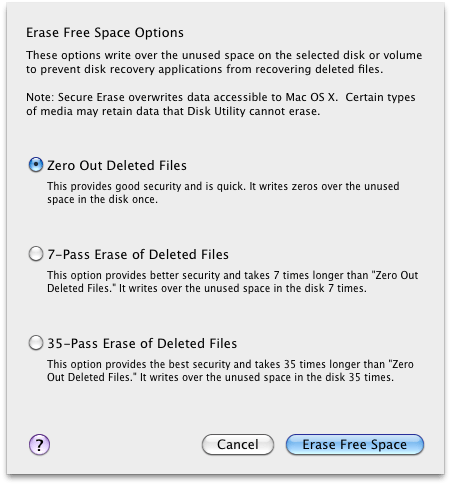When deleting a file, most operating systems just delete the reference to this file, not its actual content. For illustration, that’s like removing a chapter from a book’s table of contents without actually removing (and shredding) the according pages in the book.
So, in order to really (securely) delete a file on a hard disk, there are basically two methods (simplified; from a technical point of view it’s both the same):
- So I turned on Disk Utility and I clicked on my Mac OS partition, pressed 'Erase' and then pressed Erase Free Space. As I am typing it, it has about an hour and a half left to do. Now I thought that this would entirely remove every file that I ever deleted so that they cannot even be recovered later.
- There are two methods to check available space on a hard drive: 1. Access the Apple menu and select About this Mac. Choose the Storage tab. More detailed information can be found within the Disk Utility feature, which is located in the Applications folder under Utilities.
When you check the free disk space on your Mac, you will get the bad news about the “Disk is Almost Full”. Lightroom 6 serial number generator. That means a large amount of files are occupying most of the disk space on your Mac. What you need is to delete those junk files and clear disk space on the device.
- Overwrite the file content (i.e. its clusters) with random data
- Delete the file as usual, empty the trash and overwrite the whole free space on the according hard disk with random data
For the second method, here’s how to do it using Mac OS X:
Free Up Space on MacBook Air or MacBook Pro ( 12 Easy Ways) 1. Delete Large Files on your Mac. Instead of deleting a hundred small files and images, first of all, let us go for the big fish. Click on the Apple logo from the upper left and select About This Mac. Now, click on Storage and then click on Manage. Click Documents. Encrypt your storage. Storage encryption combined with a secure password protects all of your data, including against any data that might remain on a failing or failed or replaced storage device; including any remaining data in a hard disk free space. The Secure Erase operation is the analog to a pattern overwrite in a hard disk.
- Delete the file(s) and empty the trash
- Find out the device name of the according hard disk by opening a new ‘Terminal’ window and executing the “df” command. For example, for a RAID 1 disk, the path of the disk might be something like “/dev/disk2”
- In the opened ‘Terminal’ window, execute:
diskutil secureErase freespace 1 /dev/disk2
where “1” stands for “single-pass random-fill erase” and “/dev/disk2” is the disk device (adjust this to match your disk). When prompted, enter the admin’s credentials.

Note that overwriting free space like this takes quite some time depending on the amount of free space there is and how many passes you need (e.g. use “2” for a US DoD 7-pass secure erase or “3” for a Gutmann 35-pass secure erase). For more information about diskutil and its options, see “man diskutils”.
Disk Utility User Guide
Apple File System (APFS) allocates disk space on demand. When a single APFS container (partition) has multiple volumes, the container’s free space is shared and can be allocated to any of the individual volumes as needed. Each volume uses only part of the overall container, so the available space is the total size of the container, minus the size of all volumes in the container.
On your computer, macOS is installed on a set of volumes known as a volume group. The volume group consists of one volume used for the system files (named Macintosh HD) and another volume used for data (named Macintosh HD - Data).
Add an APFS volume

Each volume you add to an APFS container can have a different APFS format, if needed.
In the Disk Utility app on your Mac, select an existing APFS volume in the sidebar, then click the Add Volume button in the toolbar.
If Disk Utility isn’t open, click the Launchpad icon in the Dock, type Disk Utility in the Search field, then click the Disk Utility icon .
Enter a name for the new APFS volume.
Click the Format pop-up menu, then choose an APFS format.
If you want to manually manage APFS volume allocation, click Size Options, enter values in the fields, then click OK.
Reserve Size: The optional reserve size ensures that the amount of storage remains available for this volume.
Quota Size: The optional quota size limits how much storage the volume can allocate.
Click Add.
When the operation is finished, click Done.
Delete an APFS volume
When you delete a volume, all the data on the volume is permanently erased and the volume is removed from the container.
In the Disk Utility app on your Mac, select the APFS volume you want to delete in the sidebar.
If Disk Utility isn’t open, click the Launchpad icon in the Dock, type Disk Utility in the Search field, then click the Disk Utility icon . Mutetone is now 64 bit aax for mac.
Tema laptop windows 10. Click the Delete Volume button in the toolbar.
If the Delete Volume button is dimmed, the selected volume can’t be deleted because it’s in use. To delete the volume, you need to open Disk Utility in macOS Recovery. See the Apple Support article About macOS Recovery.
Do one of the following:
If the APFS volume you want to delete is a member of a volume group, click the Delete Volume Group button to delete all volumes in the group, or click the Delete button to delete only the selected volume.
Click the Delete button to delete the selected volume.
When the operation is finished, click Done.
How To Free Up Space On Mac
Erase an APFS volume
When you erase a volume, all the data on the volume is permanently erased and the empty volume remains in the container.
Secure Erase Free Space

In the Disk Utility app on your Mac, select the APFS volume you want to erase in the sidebar.
If Disk Utility isn’t open, click the Launchpad icon in the Dock, type Disk Utility in the Search field, then click the Disk Utility icon .
Click the Erase button in the toolbar.
If the Erase button is dimmed, the selected volume can’t be erased because it’s in use. To erase the volume, you need to run Disk Utility in macOS Recovery. See the Apple Support article About macOS Recovery.
Enter a new name for the volume, if desired.
If you want to change the format, click the Format pop-up menu, then choose an APFS format.
Do one of the following:
If the APFS volume you want to erase is a member of a volume group, click the Erase Volume Group button to erase all volumes in the group, or click the Erase button to erase only the selected volume.
If the APFS volume you want to erase isn’t a member of a volume group, click the Erase button to erase the selected volume.
When the operation is finished, click Done.
You can’t delete or erase your startup volume. See Erase and reformat a storage device.